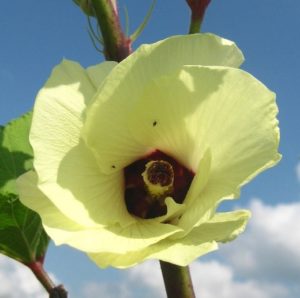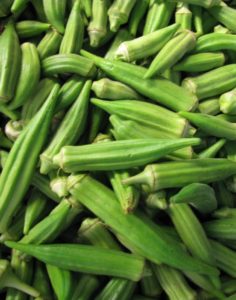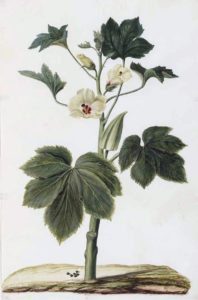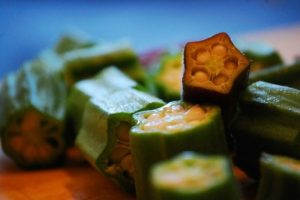In honor of Black History Month, February’s plant of the month is an important African Diaspora food: Okra!
Characteristics:

“Okra (Abelmoschus esculentus)” by tonrulkens, CC PDM 1.0.
- Okra (Abelmoschus esculentus) belongs to the Mallow or Malvaceae plant family. Plants in this family include okra, cotton, and poppymallow. The Cacao (Sterculiaceae) family is also now considered by taxonomists to be a subfamily of the Mallow family. Mallow leaves are alternate and usually palmately lobed (spread out like a hand), and when crushed have a slimy quality.
- The flowers are funnel-form with 3 to 5 united sepals, 5 separate petals, and numerous stamen united into a distinctive column around the pistil.
- The vegetable that we eat is actually the plant’s fruit (ovary, containing seeds) and typically consists of 5 carpels as seen in the image of the cut okra below.
- Most of the members of this family are edible, with okra most notably so.
- The slimy, mucilaginous quality is savored in gumbo and other dishes, and can also be used medicinally, comparable to aloe vera as an ointment or internally as expectorants.
History of Okra:

“Okra” by NatalieMaynor, CC BY-NC-SA 2.0.
Africans independently domesticated many plants, long before the plants were introduced to America and the rest of the world food supply. These plants include pearl (bulrush), millet, sorghum, coffee, watermelon, black-eyed peas, palm oil, the kola nut, tamarind, hibiscus, a species of rice, okra, and many more. Okra was originally grown in the tropical regions of Western Africa. Over 2,000 plant species thrived on the African continent prior to the transatlantic slave trade; and even after the removal of millions of people forced into slavery, Africans and those who were enslaved in the Americas continued innovative processes of growing food. In America, this included growing African crops, as well as adoption of similar Native American crops.

“Okra, Lady’s finger, Gumbo. Hibiscus esculentus. Moninckx, J., Moninckx atlas, vol. 2:t. 4 (1682-1701)” by Swallowtail Garden Seeds, CC BY-2.0.
The increase in archaeology of plantations has revealed how enslaved peoples often grew gardens near their sleeping quarters to supplement their diets. Enslaved women were often the ones who tended these gardens and were also the cooks of the slaveholder’s household. In turn, many African dietary staples became incorporated into American slaveholder diets because they were prepared by the enslaved cooks after growing them in their food plots. Okra dishes such as okra-based gumbo is an example of this. Many greens are used as thickening agents for soups and stews, such as okra, providing mucilaginous textures. In many African “porridges” okra is traditionally mixed with beans, leafy greens, and other ingredients, and then eaten with a spongy “bread.” Okra is also a major component of Afro-Creole cuisine, often mixed with tomatoes.
The “Southern cuisine” we think of is really a combination of African and Native American foods mixed with European cuisine. The archaeological plantation studies shed light on the agency of enslaved Africans in the Americas, who used their knowledge and innovation to grow crops, like okra, that would help feed, heal, and keep ties with the land they were taken from. So whenever you eat okra and other southern “soul food”, but particularly during Black History Month, think about the journey those foods took to find their way to your plate today, and who helped them thrive along the way.

“Okra” by Saucy Salad, CC BY-SA 2.0.
Okra Soup
For an authentic okra soup recipe, watch a video of Michael Twitty’s own okra soup recipe demonstrated at Gunston Hall in Mason Neck, Virginia!
For More Information:
Carney, Judith A. and Richard Nicholas Rosomoff
2009 In the Shadows of Slavery: Africa’s Botanical Legacy in the Atlantic World. University of California Press. Berkley and Los Angeles, California.
Elpel, Thomas J.
1967 Botany in a Day: The Patterns Method of Plant Identification, An Herbal Field Guide to Plant Families of North America. HOPS Press. Pony, MT.
Heath, Barbara J., and Amber Bennett
2000 “The little Spots allow’d them”: The Archaeological Study of African-American Yards”.
Historical Archaeology 34(2):38-55.
“High on the Hog: How African American Cuisine Transformed America”
2021 Documentary. Netflix.
Twitty, Michael. W.
2017 The Cooking Gene: A Journey Through African American Culinary History in the Old South. Amistad, An Imprint of HarperCollins Publishers. New York, NY.
US Department of Agriculture, Natural Resources Conservation Service
2021 PLANTS Database. Electronic document, https://plants.usda.gov/home.
